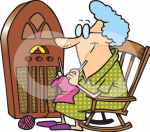First Longwave Stations
At the time when radio broadcasting first began
in Australia, radio engineers of the day considered that the widest coverage could be obtained by emitting high power on a
longwave frequency. Consequently, some of Australia's first radio broadcasting stations transmitted for some years on what
has since become the European standard longwave band.
Early 1920s
A total of five different
stations in Australia were issued licenses for longwave broadcasting, only three of these stations were launched, and all
three were involved in shortwave broadcasting. This is how it happened.
December 5, 1923
The 1st station in Australia
to operate on longwave was 2FC in Sydney, which was inaugurated as Australia's 2nd broadcasting station. This station, which
was projected under the callsign 2LO, reminiscent of the more famous 2LO in London, was constructed by AWA, with studios in
Farmer's Building in downtown Sydney, and transmitter at suburban Willoughby.
The initial channel allocated to 2FC was 1100 metres, 273 kHz, with a power of 5 kW. Three years later, the transmitter
was re-sited to the AWA facility in outer suburban Pennant Hills, still on longwave. However, at the beginning of the following
year, 2FC did transfer from the longwave band, to 442 metres, 680 kHz in the standard mediumwave band.
Broadcasting station 2FC operated on longwave for something over three
years, and it was also involved in early shortwave broadcasting. Today, 2FC is still on the air, though under the callsign
2RN, with 50 kW on 576 kHz.
Around the same time that 2FC was licensed, the owners, Farmer &
Co., obtained a license for a 2nd commercial station in Sydney under the projected callsign 2FL. This additional station was
allocated the longwave channel 880 metres, 341 kHz with a power of 1/2 kW. However, station 2FL was never launched, and the
license was cancelled.
October 131925
In Melbourne Victoria,
this same commercial organization, Farmer & Co., obtained another license for a longwave broadcasting station with 5 kW
on 1720 metres, 174 kHz. The projected callsign for this station was 3FC, though the call was changed to 3LO before the station
was inaugurated.
3LO moved into the broadcast band on 810 kHz in mid-1926. Thus, it was
on the air lon ongwave for a little over six months. It's still on the air today with 50 kW on 774 kHz, under the same callsign
3LO.
June 4 1924
In Perth, the early
wireless experimenter, Wally Coxon, involved with the erection of another longwave station, 6WF. This station was located
in the Westralian Farmers Building in downtown Perth, with two massive radio towers, each weighing 3-1/2 tons on top of the
building.
It was inaugurated on June 4, 1924, with 5 kW on 1250 metres, 240 kHz.
This station remained on longwave much longer than any of the other broadcasting stations in Australia, and it left longwave
and moved to 690 kHz five years later. Station 6WF was also involved in shortwave broadcasting; and it is still on the air
today with 50 kW on 720 kHz under the same callsign 6WF.
1923
The 5th license for a longwave broadcasting
station in Australia was issued to Millswood Auto & Radio Co. Ltd., in Adelaide, South Australia. They were allocated
the longwave channel 850 kHz with 3 kW under the callsign 5MA in the year 1923. Millswood announced that they intended to
inaugurate their new station towards the end of the year 1923, though the usual delay occurred.
In preparation for their new radio broadcasting service, they installed
a temporary transmitter with just 250 watts output. It would appear that some test broadcasts were radiated from this temporary
unit, but when the PMG Dept issued a new set of regulations for radio broadcasting in Australia, Millswood withdrew, and the
license for 5MA was cancelled.
Thus, a total of 5 different licenses for longwave broadcasting were
issued by the PMG Dept in Australia. Two stations, though projected, were never inaugurated; stations 2FL in Sydney and 5MA
in Adelaide. Three stations were placed on the air; 2FC in Sydney, 3LO in Melbourne, and 6WF in Perth.
The era of longwave broadcasting in Australia began officially on December
5, 1923 with the official inauguration of 2FC Sydney, and it ended nearly six years later when station 6WF in Perth was transferred
into the mediumwave band on September 2, 1929.

